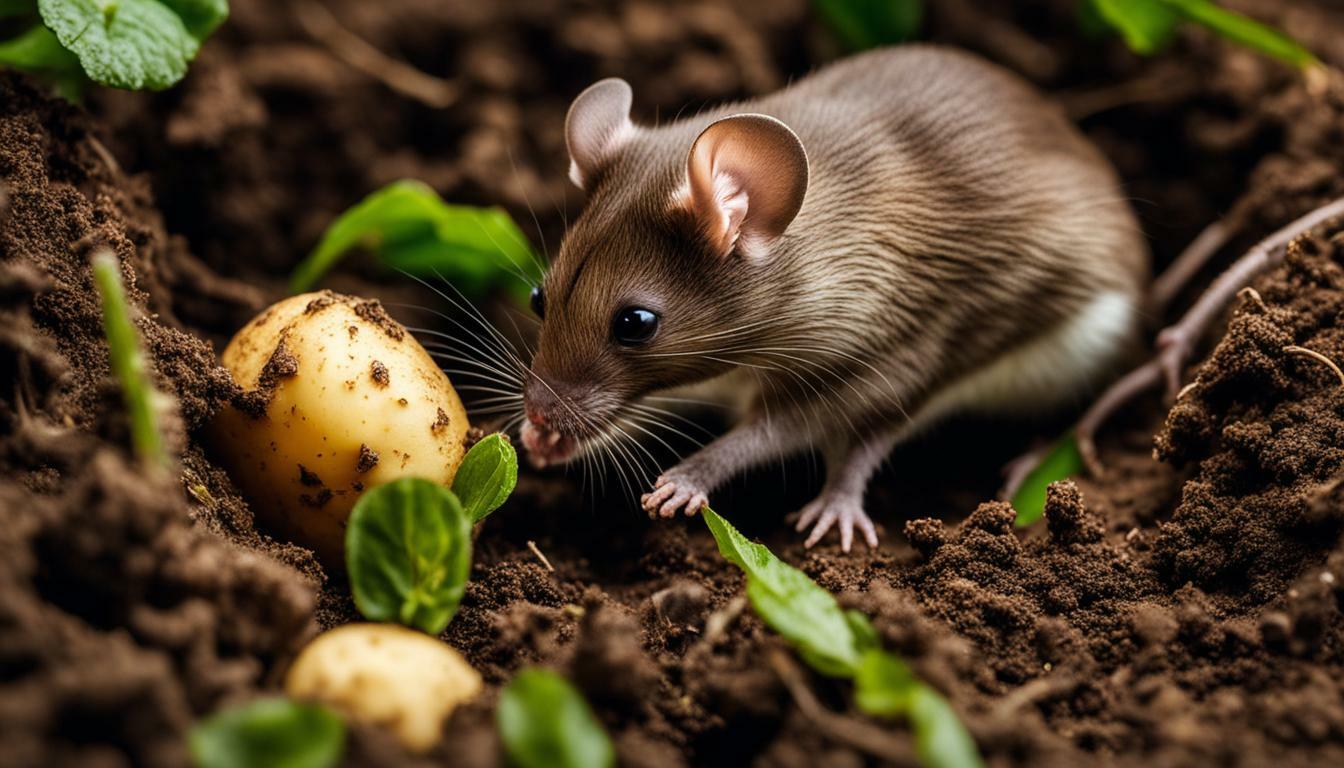If you’ve ever wondered whether mice have a taste for potatoes, the answer is yes – under certain circumstances, these small rodents will readily devour this starchy vegetable. Mice are known to dig through garden soil in search of potato tubers and will gnaw on them until satisfied, especially if other food choices are limited. While they are not as problematic as voles, mice will still turn to potatoes as a food source if necessary.
Key Takeaways:
- Mice will eat potatoes if other food options are scarce.
- Signs of potato damage caused by mice or voles include bite marks and scrape marks.
- Preventive measures such as planting potatoes at least four inches deep and using straw mulch can help protect crops.
- Traps baited with peanut butter can be effective in capturing mice and voles.
- Using galvanized metal hardware cloth and castor oil-based granular repellents can help deter these critters.
Rodent Diet and Potato Consumption
Understanding the diet preferences of mice is crucial to comprehending why they find potatoes appealing and why they might turn to them as a food source. Mice have a diverse diet that consists of various grains, seeds, fruits, and vegetables. However, when other food options are limited, mice will not hesitate to consume potatoes.
Potatoes provide an attractive food source for mice due to their high nutritional value. These tubers are rich in carbohydrates, which provide mice with the energy they need to survive. Additionally, potatoes contain essential nutrients such as vitamins C and B6, as well as minerals like potassium and manganese. When other food sources become scarce, mice instinctively seek out potatoes as a way to sustain themselves.
While mice are not as problematic as voles when it comes to damaging potato crops, they can still cause significant harm. Mice are known to burrow through garden soil in search of potato tubers. Once they find these underground treasures, they will gnaw on them until satisfied. Gardeners must be vigilant in identifying signs of potato damage caused by mice or voles, such as visible bite marks and scrape marks on the tubers.
| Prevention Methods to Deter Mice and Voles |
|---|
| Plant potatoes at least four inches deep to deter burrowing. |
| Use straw mulch around potato plants to provide an added layer of protection. |
| Set up traps baited with peanut butter to capture and remove mice from the garden. |
| Line raised beds with galvanized metal hardware cloth to prevent mice and voles from accessing the tubers. |
| Apply castor oil-based granular repellents around the garden to deter these critters. |
In summary, mice do eat potatoes, especially when other food choices are limited. Their inclination towards potatoes is due to their nutritional value and the scarcity of alternative food options. To protect potato crops from mouse damage, gardeners can employ prevention methods such as planting potatoes at a sufficient depth, using straw mulch, setting traps baited with peanut butter, lining raised beds with hardware cloth, and using castor oil-based repellents. By implementing these strategies, gardeners can ensure that their potato harvest remains intact and free from the predations of these hungry rodents.
Signs of Potato Damage and Prevention Methods
Spotting the tell-tale signs of mouse or vole damage on your potato plants is the key to taking proactive measures to protect your harvest. These rodents can wreak havoc on your crops, leaving behind noticeable signs of their presence. Look out for bite marks and scrape marks on the potato tubers, as these are typical indicators of rodent activity.
To prevent mice and voles from damaging your potatoes, there are several effective methods you can employ. Firstly, ensure that you plant your potatoes at least four inches deep. This depth makes it more challenging for rodents to reach the tubers, reducing the risk of them being targeted as a food source. Additionally, using straw mulch around the plants can act as a protective barrier, making it harder for rodents to access the potatoes.
Traps can be an efficient way to catch and remove mice and voles from your garden. Bait these traps with peanut butter or other enticing foods to attract the critters. Be sure to regularly check and reset the traps as needed. Another preventive measure is to line raised beds with galvanized metal hardware cloth, which creates an additional physical barrier to deter rodents.
For those wanting a more natural approach, consider using castor oil-based granular repellents. These products create an unpleasant scent that repels mice and voles, effectively deterring them from your potato plants. Apply the repellent according to the manufacturer’s instructions, and reapply as necessary to maintain its effectiveness throughout the growing season.
| Potato Damage Signs | Prevention Methods |
|---|---|
| Bite marks on potato tubers | Plant potatoes at least four inches deep |
| Scrape marks on potato tubers | Use straw mulch for added protection |
| Set traps baited with peanut butter | |
| Line raised beds with galvanized metal hardware cloth | |
| Apply castor oil-based granular repellents |
Strategies to Deter Mice and Voles
Don’t let mice and voles feast on your potatoes – discover effective strategies that can help keep these critters at bay. These rodents have a knack for finding their way into gardens and wreaking havoc on potato crops. But fear not, as there are proven methods to deter them and protect your hard-earned harvest.
Planting Depth and Mulch
One of the first lines of defense against mice and voles is planting potatoes at a sufficient depth. By burying them at least four inches deep, you make it more difficult for these critters to access the tubers. Additionally, using straw mulch around the plants provides an extra layer of protection. It acts as a deterrent by making it harder for mice and voles to locate and gnaw on the potatoes.
Traps and Repellents
If you notice signs of potato damage caused by mice or voles, it’s time to take action. Setting traps baited with peanut butter can be an effective way to catch these rodents. Place the traps near the potato plants, ensuring they are secure and easily accessible for the pests. Additionally, using galvanized metal hardware cloth to line raised beds can prevent mice and voles from burrowing into the soil.
Another option is to use castor oil-based granular repellents. These repellents create an unpleasant environment for mice and voles, deterring them from approaching the potato crops. Apply the granules around the perimeter of the garden and near the potato plants, following the manufacturer’s instructions for proper usage.
Stay One Step Ahead
While it’s true that mice also eat other foods like cheese and peanut butter, they will resort to potatoes if they’re starving. It’s crucial to remain vigilant and take preventive measures to safeguard your potato crops. By implementing a combination of planting depth, mulch, traps, and repellents, you can significantly reduce the risk of mice and voles feasting on your potatoes.
Remember, mice and voles are resourceful creatures, so it’s important to stay one step ahead. By following these strategies and regularly inspecting your potato plants for any signs of damage, you can ensure a bountiful harvest free from unwanted rodent destruction.
| Strategies to Deter Mice and Voles |
|---|
| Plant potatoes at least four inches deep |
| Use straw mulch around the plants |
| Set traps baited with peanut butter |
| Line raised beds with galvanized metal hardware cloth |
| Apply castor oil-based granular repellents |
Conclusion
In conclusion, while mice may not be potato enthusiasts by nature, they will not hesitate to consume them if necessary, making it essential for gardeners to take appropriate precautions to safeguard their crops.
Mice are known to eat potatoes when other food options are scarce. They are capable of burrowing through garden soil in search of potato tubers and will gnaw on them until satisfied. However, it is important to note that mice are not as problematic as voles when it comes to potato damage.
To prevent mice and voles from damaging potato crops, there are several effective strategies that gardeners can employ. Planting potatoes at least four inches deep can deter mice from accessing the tubers. Using straw mulch as a protective barrier can also help prevent these critters from reaching the crops. Additionally, setting traps baited with peanut butter can lure and capture mice that venture into the garden.
Other preventive measures include lining raised beds with galvanized metal hardware cloth to keep out burrowing rodents and using castor oil-based granular repellents to deter mice and voles. By implementing these strategies, gardeners can significantly reduce the risk of potato damage and protect their crops.
FAQ
Do mice eat potatoes?
Yes, mice do eat potatoes, especially if other food choices are scarce. They are known to burrow through garden soil in search of potato tubers and will gnaw on them until satisfied.
What are the signs of potato damage caused by mice or voles?
The signs of potato damage caused by mice or voles include bite marks and scrape marks on the tubers. These can be indicators of their activity in the garden.
How can I prevent mice and voles from damaging my potatoes?
To prevent mice and voles from damaging potatoes, you can plant them at least four inches deep, use straw mulch for protection, and set traps baited with peanut butter. Using galvanized metal hardware cloth to line raised beds and employing castor oil-based granular repellents can also deter these critters.
Do mice eat other foods besides potatoes?
While mice do eat other foods like cheese and peanut butter, they will eat potatoes if they are starving or if other food sources are limited.




